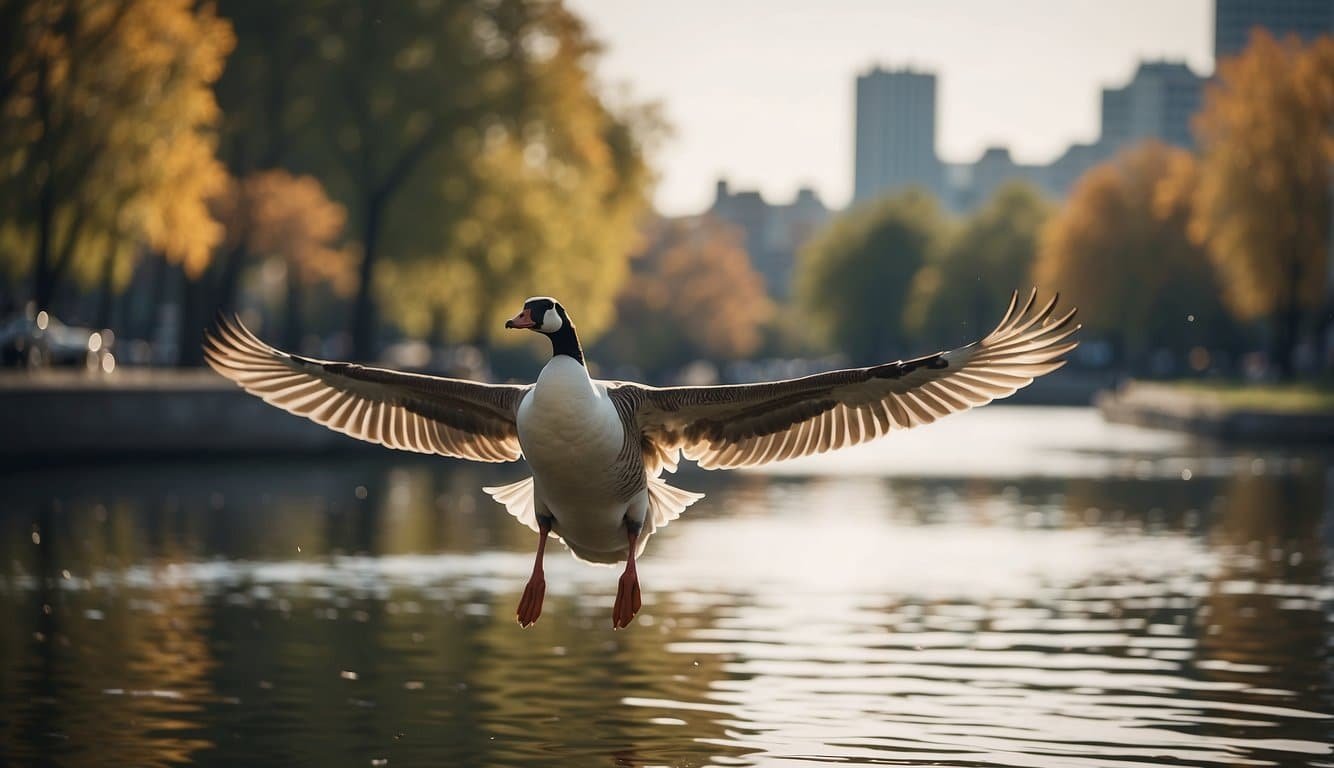Goose Flight Capabilities
Geese are remarkable aviators, exhibiting stunning flight capabilities that have been honed through millennia of evolution. They harness a suite of physical adaptations to master the skies and undertake long migratory journeys across continents.
Physical Adaptations for Flight
Geese are equipped with strong, broad wings that enable efficient, long-distance travel. Their wings are complemented by lightweight, hollow bones and powerful pectoral muscles, the engines behind their flight. The design of their feathers also aids in reducing drag and preserving warmth during high-altitude flights. For instance, the Bar-headed Goose has unique adaptations that allow it to fly over the Himalayas, demonstrating an impressive adaptability to some of the earth’s most challenging environments.
Migration Patterns and Behaviors
Migration is synonymous with geese, as they are known for their seasonal travel from breeding grounds in North America to warmer southern locales each fall, returning north in the spring. These migratory birds have a tremendous navigational capacity, possibly using the Earth’s magnetic field to chart their course. Their migratory routes, or flyways, feature strategic rest stops, facilitating replenishment of fat reserves crucial for the journey. Some species, such as the Snow Goose, travel thousands of miles between their summer and winter ranges.
Social and Flocking Dynamics
Geese are highly social creatures, most recognizable by their V formation flying pattern. This formation increases the efficiency of flight thanks to the updrafts created by the bird in front, conserving energy for the whole flock. The intricate social structure of a flock involves vigilant communication and coordination, particularly during migrations. Female geese, or hens, lead their young during the first year of life, teaching them the ins and outs of social behavior and migratory routes. Whether it’s the tight-knit family units or the larger flocks, geese exhibit complex social behaviors that are crucial for their survival during their long flights. The Canada Goose, known as Branta canadensis, is especially well-observed in this regard, with flocks often spotted over various regions of North America.
Goose Interaction With Human Environments

Geese have become a common sight in many human environments, often leading to conflicts as well as becoming an integral part of urban wildlife ecosystems.
Goose-Human Conflicts and Management
Interactions between geese and humans can lead to various challenges, particularly in urban settings where the birds may settle on lawns, golf courses, and in parks. The Canada goose, with its adaptability to various landscapes including those altered by humans, often feeds on grasses, seeds, and grains, which can lead to the overgrazing of public and private greenspaces. In some areas, geese have become a nuisance, leaving behind waste that can pollute environments and pose a danger to human health.
Efforts to manage these bird populations include non-lethal methods such as habitat modification to make the areas less attractive to geese, and the use of trained dogs or noise devices to chase them away. In regards to aviation safety, special strategies have been developed to reduce the risks of geese flying near airports, as documented in “Conflicts between expanding goose populations and aviation safety”.
Geese as Part of Urban Wildlife
Despite the challenges, geese play a vital role in urban ecosystems. Species like the brant, brent geese, and greylag goose can be found foraging on berries or seeds in public spaces, much to the delight of local birdwatchers and naturalists. The adaptation of geese to living in close quarters with humans has also provided opportunities for people to observe and appreciate wildlife in their local parks and recreational areas.
In some cultures, such as in Egypt, geese have been domesticated for centuries, valued for their down feathers and sometimes even used as guard animals. Conservation efforts have been successful in recovering certain goose populations to the extent that they’ve transitioned from being threatened species to abundant in parts of the Arctic and North America. The complex relationship between geese and humans is a testament to both the adaptability of these birds and the impact of human activity on wildlife habitats.
Diet and Nutrition of Geese

Geese are herbivorous birds with a varied diet that heavily depends on their habitat and the season. Understanding what geese eat and how their eating patterns change throughout the year provides insight into their behavior and survival strategies.
Feeding Habits and Foraging
Geese have adapted to forage on a wide range of foods. Their diet mainly consists of grass, grains, and aquatic plants, but they also eat berries and seeds if available. Canada geese, for example, are often seen grazing in fields, where they consume large quantities of grass and crops. In water, they dip their heads below the surface to reach aquatic vegetation. This diverse diet helps sustain them in different environments, from the rural countryside of Northern Europe and Scandinavia to the parks and wildlands across the Atlantic.
During migration, geese prioritize high-energy foods to accumulate fat reserves. These reserves are crucial for their long journeys, which can take them from the Arctic to as far south as Egypt or Japan. Along the way, they might also feed on leftover grains in agricultural fields or waste grains, demonstrating their remarkable ability to adapt to various food sources provided by the landscape.
Impact of Seasonal Changes
The seasonal changes significantly impact the diet and nutrition of geese. In spring and summer, they have access to an abundance of green forage that allows them to build up their nutrient stores. However, the approach of winter prompts a shift towards energy-rich foods like grains to amass fat reserves. These reserves are essential for migration, allowing geese to survive the journey to warmer areas.
During the colder months, if conditions are harsh and food scarce, geese have been known to adjust their feeding patterns, foraging at unusual times or seeking out atypical food sources. This adaptability is one key to their survival in the wild and is one of the many fascinating aspects of their behavior observed by wildlife enthusiasts.

